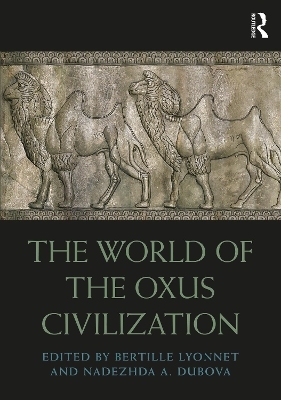
The World of the Oxus Civilization
Routledge (Verlag)
978-1-032-57003-7 (ISBN)
First discovered in the 1970s, the Oxus Civilization, or the Bactria–Margiana Archaeological Complex (BMAC), has engendered many different interpretations, which are explored in this volume by an international group of archaeologists and researchers. Contributors cover all aspects of this fascinating Bronze Age culture: architecture; material culture; grave goods; religion; migrations; and trade and interactions with neighboring civilizations, from Mesopotamia to the Indus, and the Gulf to the northern steppes. Chapters also examine the Oxus Civilization’s roots in previous local cultures, explore its environmental and chronological context, or the possibly coveted metal sources, and look into the reasons for its decline.
The World of the Oxus Civilization
offers a broad and fascinating examination of this society, and provides an invaluable updated resource for anyone working on the culture, history, and archaeology of this region and on the multiple interactions at work at that time in the ancient Near East.
Bertille Lyonnet is Directrice de Recherches Emeritus at the French National Center for Scientific Research (CNRS), Paris, as an archaeologist. She has worked in Central Asia (Afghanistan, Tadjikistan, and Uzbekistan), northeastern Syria, the northern Caucasus, and Azerbaijan. A specialist in ceramics, she has always shown a particular interest in the interrelations between the different areas of the world where she has worked. She is the author of several books and over 150 articles. Nadezhda A. Dubova is a main researcher and head of the Center of Human Ecology at the Institute of Ethnology and Anthropology (IEA) of the Russian Academy of Sciences, Moscow, Russia. She was the head and/or a member of more than 60 physical anthropological and archaeological expeditions in Russia, Central Asia, Iran, and the Moldova Republic. She now heads the International Russian-Turkmen Margiana archaeological expedition. She gives lectures at different universities (Lomonosov Moscow, Ufa (Bashkortostan), Voronezh, South Kazakhstan (Shimkent), and Bern (Switzerland)). She is the author and editor of more than 400 publications on physical anthropology, human ecology, Eurasian archaeology, and theoretic problems of anthropology.
Introduction PART I: THE OXUS CIVILIZATION BACKGROUND 1. Questioning the Oxus Civilization or Bactria-Margiana Archaeological Culture (BMAC): an Overview 2 The Oxus Civilization and Mesopotamia: A Philologist’s Point of View 3. Environmental Changes in Bactria and Sogdiana (Central Asia, Afghanistan, and Uzbekistan) from the Neolithic to the Late Bronze Age: Interaction with Human Occupation 4. The Rise of the Early Urban Civilization in Southwestern Central Asia (from the Middle Chalcolithic to the Middle Bronze Age in Southern Turkmenistan) PART II: THE "CORE AREA" 5. The Architecture of the Bactria-Margiana Archaeological Culture 6. Some Thoughts on the Imaginary Representations in the Bactria-Margiana Archaeological Culture 7. Myths and Gods in the Oxus Civilization 8. BMAC Glyptics: Typology, Context, Function, and Background 9. Chlorite Containers from the Oxus Civilization: Between Technical Choices and Iconographic Codes 10. The "Royal Necropolis" at Gonur Depe: an Attempt at Systematization (Plan, Constructions, Rituals) 11. Polychrome Inlayed and Painted Mosaics from Gonur Depe (Turkmenistan) 12. Animal Burials at Gonur Depe 13. Funerary Rituals and Archaeothanatological Data from BMAC Graves at Ulug-Depe (Turkmenistan) and Dzharkutan (Uzbekistan) 14. Bioarchaeology of the BMAC Population: A Short Review 15. Animal Exploitation at Gonur Depe 16. Life in the Countryside: the Rural Archaeology of the Sapalli Culture 17. Who Interacted with Whom? Re-Defining the Interaction between BMAC People and Mobile Pastoralists in Bronze Age Southern Turkmenistan 18. The End of the Oxus Civilization PART III: THE "SURROUNDING AREAS" 19. The BMAC Presence in Eastern Iran: State of Affairs in December 2018. --Towards the Greater Khorasan Civilization? 20. The Relationship between the Oxus Civilization and the Indo-Iranian Borderlands 21. Interaction between the Worlds of South Asia and Central Asia 22. The Oxus Civilization/BMAC and its Interaction with the Arabian Gulf: A Review of the Evidence 23. The Formation of the Oxus Civilization/BMAC in Southwestern Tajikistan 24. The Zeravshan Regional Variant of the Bactria-Margiana Archaeological Complex: Interaction between Two Cultural Worlds 25. The "Classical Vakhsh Culture": a Bronze Age Culture of the 3rd and early 2nd Millennium BC in Southern Tajikistan 26. The Oxus Civilization and the Northern Steppes PART IV: METALS AND METAL DEPOSITS 27. Archaeometallurgical Studies on BMAC Artifacts 28. Metal Sources (Tin and Copper) and the BMAC 29. The Acquisition of Tin in Bronze Age Southwest Asia APPENDIX: Radiocarbon Dates Related to the BMAC/Oxus Civilization
| Erscheinungsdatum | 10.07.2023 |
|---|---|
| Reihe/Serie | Routledge Worlds |
| Zusatzinfo | 310 Illustrations, black and white |
| Verlagsort | London |
| Sprache | englisch |
| Maße | 174 x 246 mm |
| Gewicht | 1640 g |
| Themenwelt | Geisteswissenschaften ► Archäologie |
| Geschichte ► Allgemeine Geschichte ► Vor- und Frühgeschichte | |
| Geschichte ► Allgemeine Geschichte ► Altertum / Antike | |
| Naturwissenschaften ► Geowissenschaften ► Geografie / Kartografie | |
| ISBN-10 | 1-032-57003-2 / 1032570032 |
| ISBN-13 | 978-1-032-57003-7 / 9781032570037 |
| Zustand | Neuware |
| Informationen gemäß Produktsicherheitsverordnung (GPSR) | |
| Haben Sie eine Frage zum Produkt? |
aus dem Bereich


